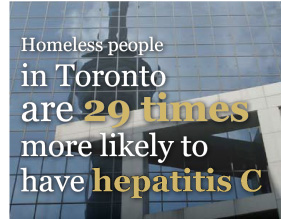Yesterday, the United Nations marked World Hepatitis Day, a day to “prevent and defeat hepatitis”, a virus infection that affects 1 in 3 people around the world. This number is much smaller for most people in Canada. However, it continues to be quite prevalent amongst those experiencing homelessness. Hepatitis refers to 5 viruses (labeled A through E). The studies in this post focused on Hepatitis B and C, both of which are contracted through bodily fluids. Hepatitis B virus is 50-100 times more infectious than HIV. Hepatitis B can be lethal, but it can also be prevented with a 3 dose vaccination. Hepatitis C can lead to long-term kidney failure and kidney cancer. Hepatitis C is treatable, and in many cases curable, with antibiotics.
The risk of contracting either of these infections can be made even greater with use of injection drugs and participation in higher risk sex (in exchange for money). Both of these activities can be coping mechanisms for those who are most marginalized and experiencing homelessness. The researchers I have worked with to complete these summaries have focused on hepatitis as it relates to: prevalence, prevention, palliative care and education.
Dr. Judith A. Stein completed research on homelessness and the prevalence of hepatitis infections. Her work was predominantly done in the “skid row” neighborhood of Los Angeles. Those who are homeless with hepatitis are less likely to know that they are infected. Those who had consistent case management and medical support were more likely to be aware of their infection. A second study by the same author focused on vaccination for Hepatitis B. The requirement of 3 doses to immunize for hepatitis B is often seen as a barrier to treatment. Those who experience homelessness may find it difficult to return to places to receive 2nd and 3rd doses. The research found that case management was the most important to help people complete the process.
Those who are experiencing homelessness in Toronto are 29 times more likely to have the hepatitis virus. Hepatitis in Toronto leads to additional problems when people who are experiencing homelessness are nearing end of life. Dr. Yonah Krakowsky found that those experiencing homelessness in Toronto are not receiving adequate end of life care. Staff who regularly run programs for those experiencing homelessness require additional training on discussions on topics related to death and dying.
Another study of palliative care also addresses risk associated with hepatitis. Dr. Stacey A. Page noticed a connection between the prevalence of hepatitis, HIV and cancer to a lack of access to healthcare. Barriers to continued treatment prevent people from accessing the care that they need. The research looked at records of those who were homeless when they died. The majority of those who died would have been more comfortable had they had access to treatment at their end of their life.
Education programs are important in order to prevent Hepatitis infection, and to inform people about possible treatments. Dr. Adeline Nyamathi completed a study of two different Hepatitis and HIV education programs for youth experiencing homelessness. One of the programs focused on a nurse-led model, while the other focused on an art intervention model. It is important evaluate the effectiveness of interventions. This research provides a strong argument for the need to test our assumptions, and to understand the importance of good field staff in running successful programs.
Isaac Coplan is a Masters student in Environmental Studies at York University. Isaac is working with Research Impact and the Homelesshub on Knowledge Mobilization. Isaac’s main research interests are in youth homelessness and social exclusion in Canada.


